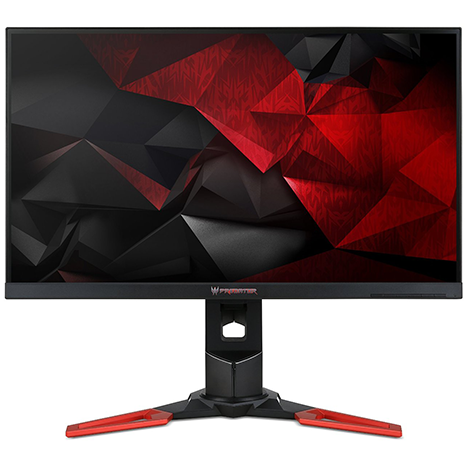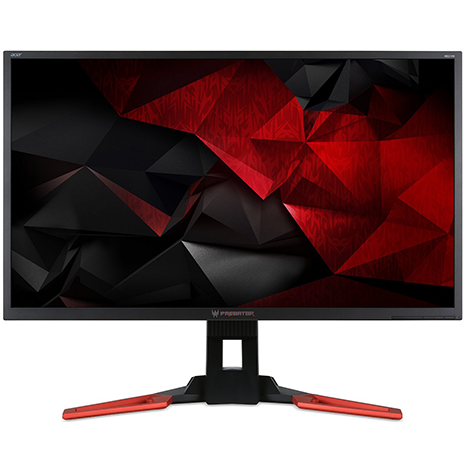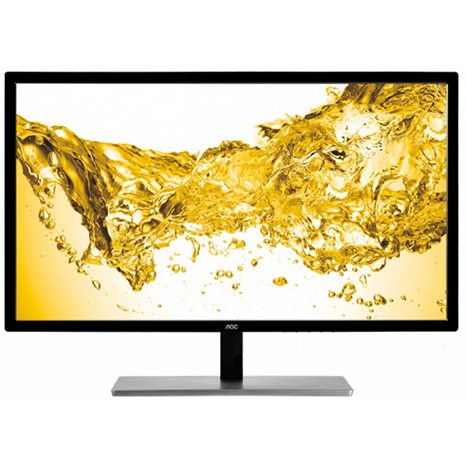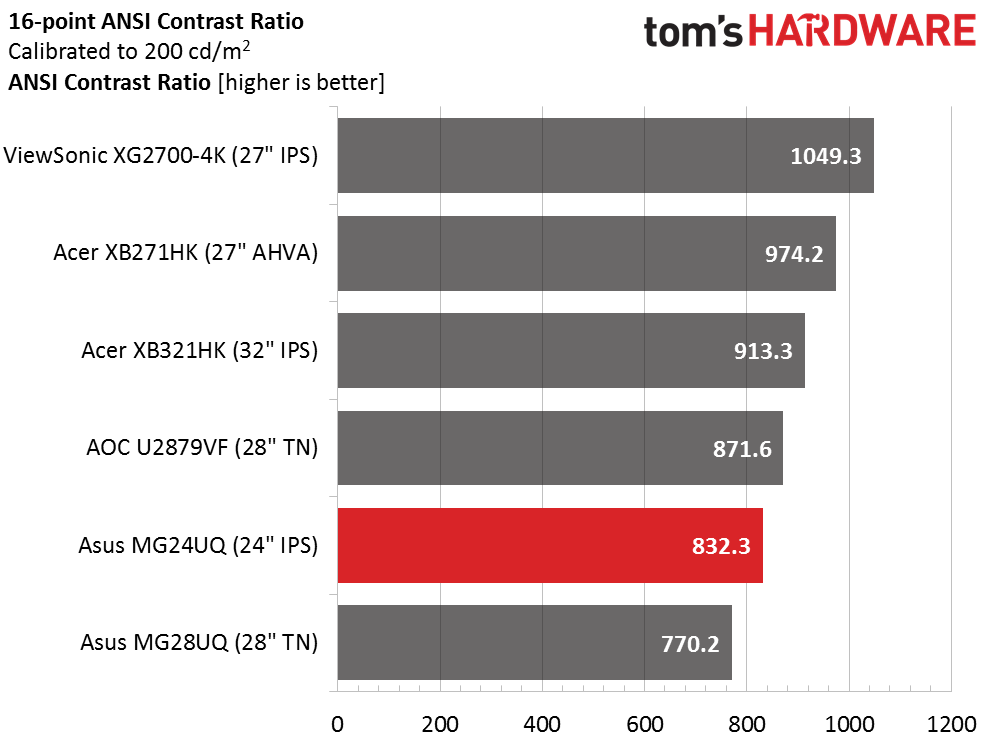Asus MG24UQ 24-inch IPS Ultra HD FreeSync Monitor Review
Gamers seeking high pixel density may want to check out the Asus MG24UQ. It’s a 24-inch IPS panel with FreeSync, Ultra HD and a shockingly low price. We’re running it through our benchmark and gaming tests today.
Why you can trust Tom's Hardware
Brightness & Contrast
To read about our monitor tests in depth, please check out Display Testing Explained: How We Test Monitors and TVs. Brightness and Contrast testing is covered on page two.
Uncalibrated – Maximum Backlight Level
FreeSync can be added to any DisplayPort 1.2-equipped monitor essentially without cost. This has given rise to several new Ultra HD model introductions in recent months. We now have a large group of high-res gaming monitors from which to choose. Today we’re including Acer’s XB271HK and XB321HK, Asus’ MG28UQ, ViewSonic’s XG2700-4K and AOC’s U2879VF in our comparison group. All offer adaptive sync and a 60Hz max refresh rate.
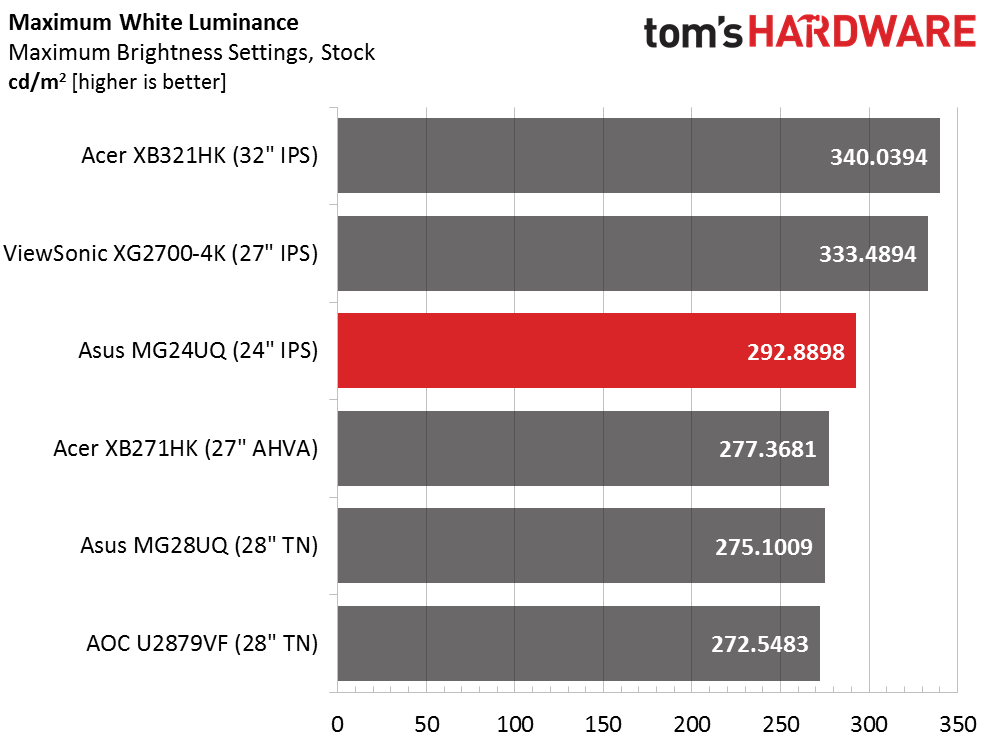
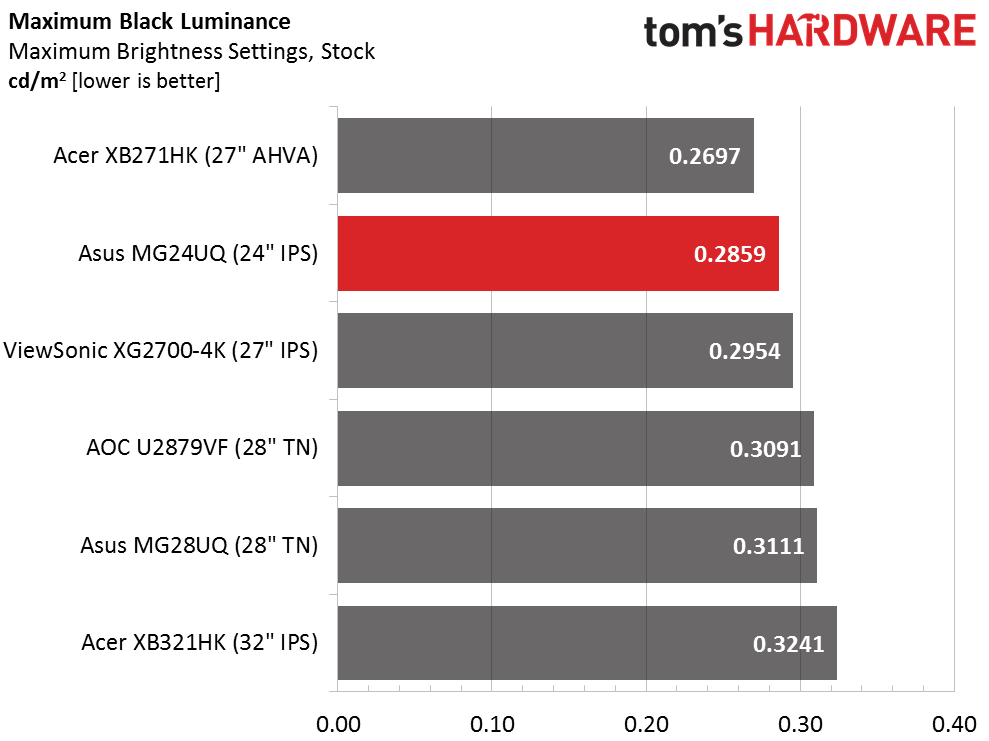
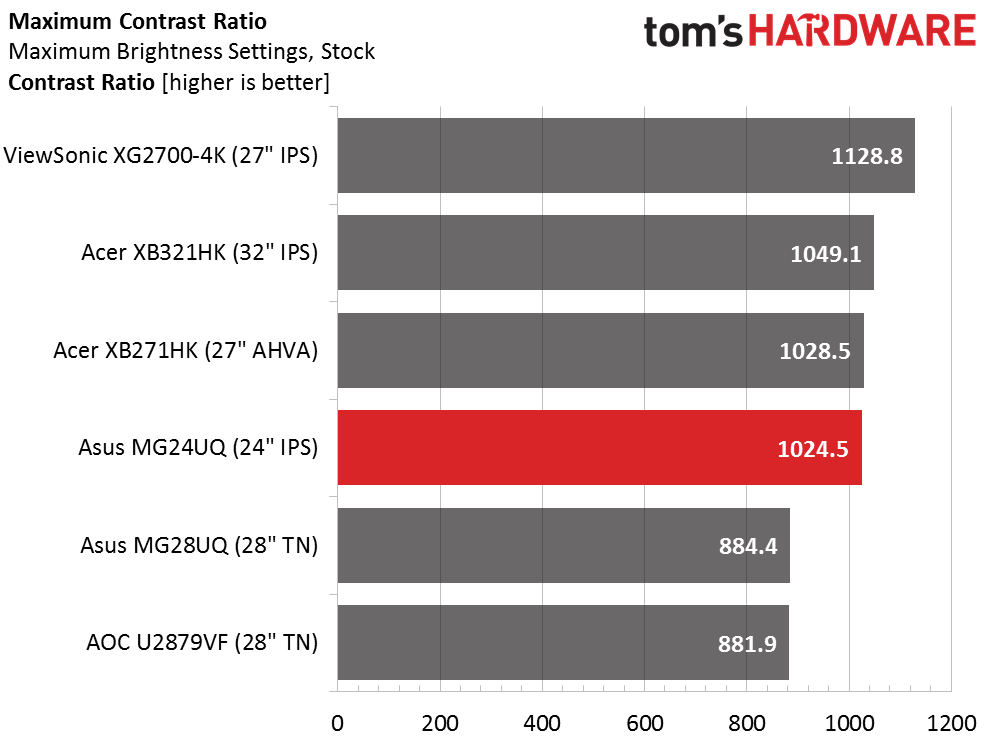
The MG24UQ measures slightly under its claimed output level of 300cd/m2. The difference is a wash and doesn’t diminish its usefulness in the slightest. With such high pixel density, there is more than enough brightness for any game or productivity application one might use it for. If you need more light, the XB321HK offers a little extra punch.
Black levels are quite respectable at the backlight’s maximum setting. IPS offers good dynamic range, although it won’t match the blacks seen on a VA or OLED screen. Resulting contrast is decent at just over 1000:1. You can increase this a little by using ASCR but some detail will be crushed at the extremes of the brightness scale.
Uncalibrated – Minimum Backlight Level
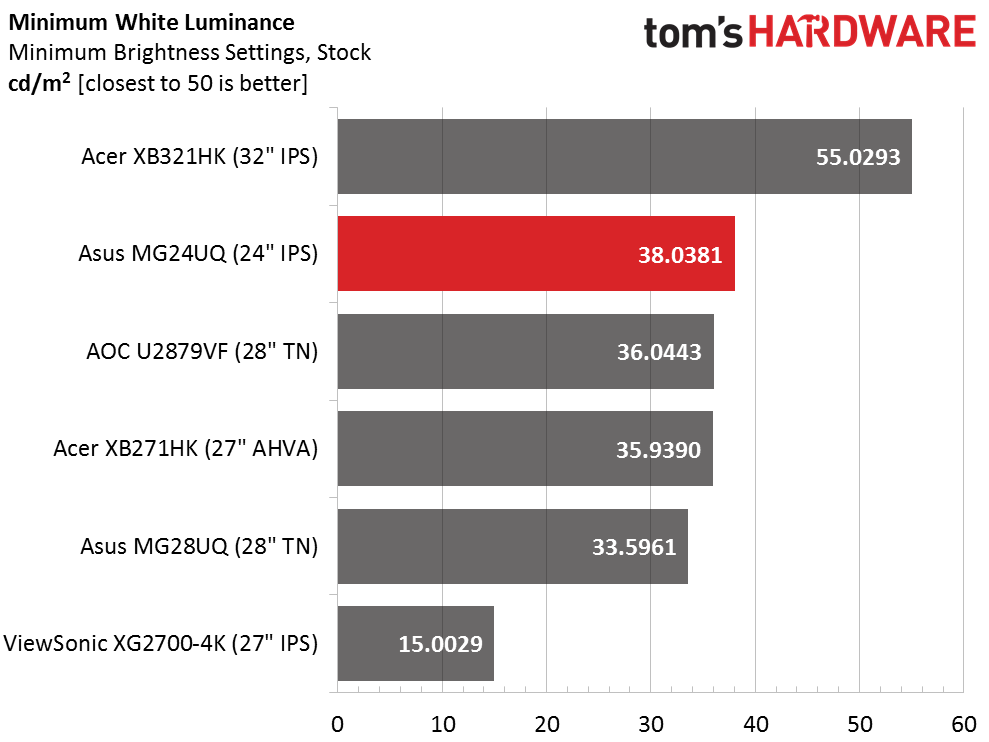
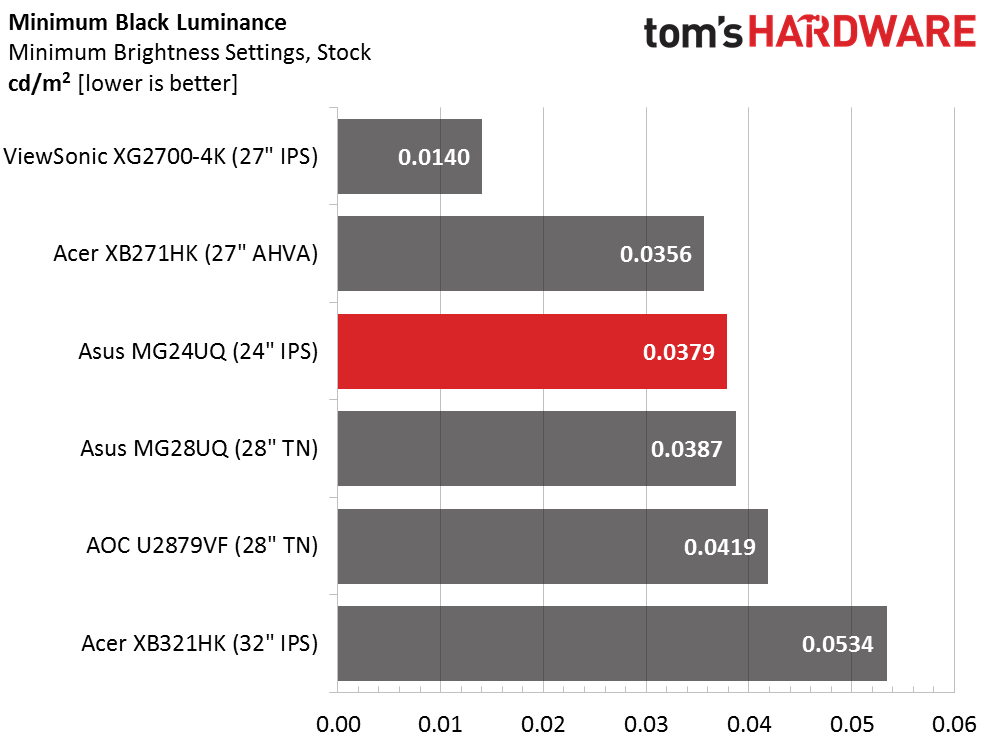
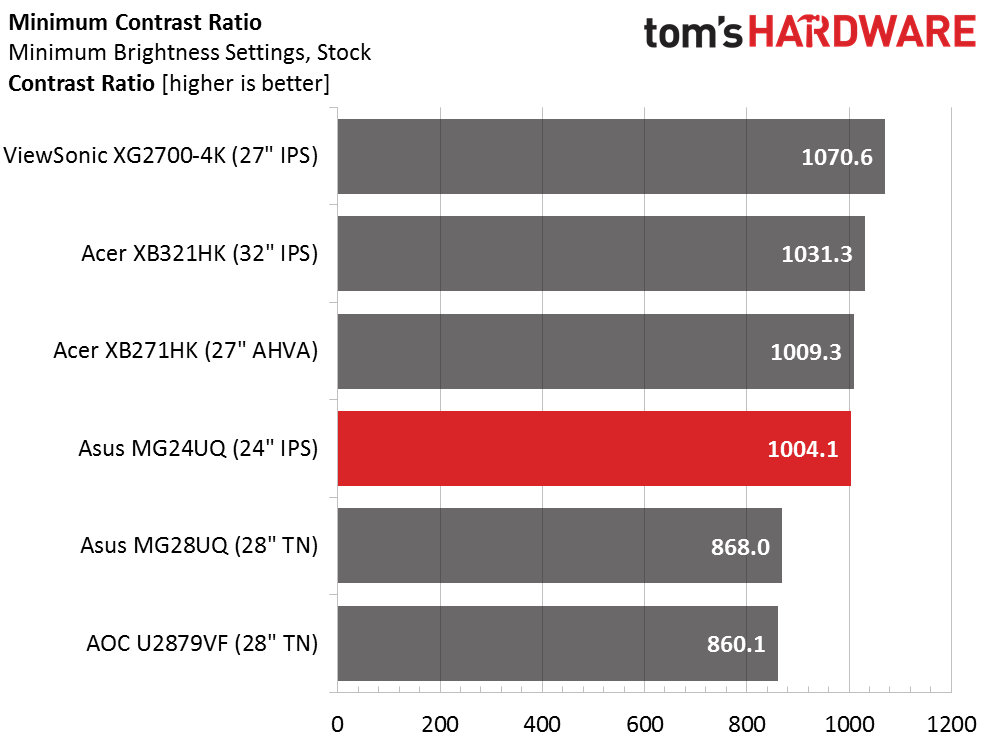
The minimum backlight level is a little lower than our preferred 50cd/m2. Just turn it up to 7 for that setting. Black levels and contrast remain consistent through the entire adjustment range. Contrast remains over 1000:1 and places it among the best of our Ultra HD gaming monitors.
After Calibration to 200cd/m2
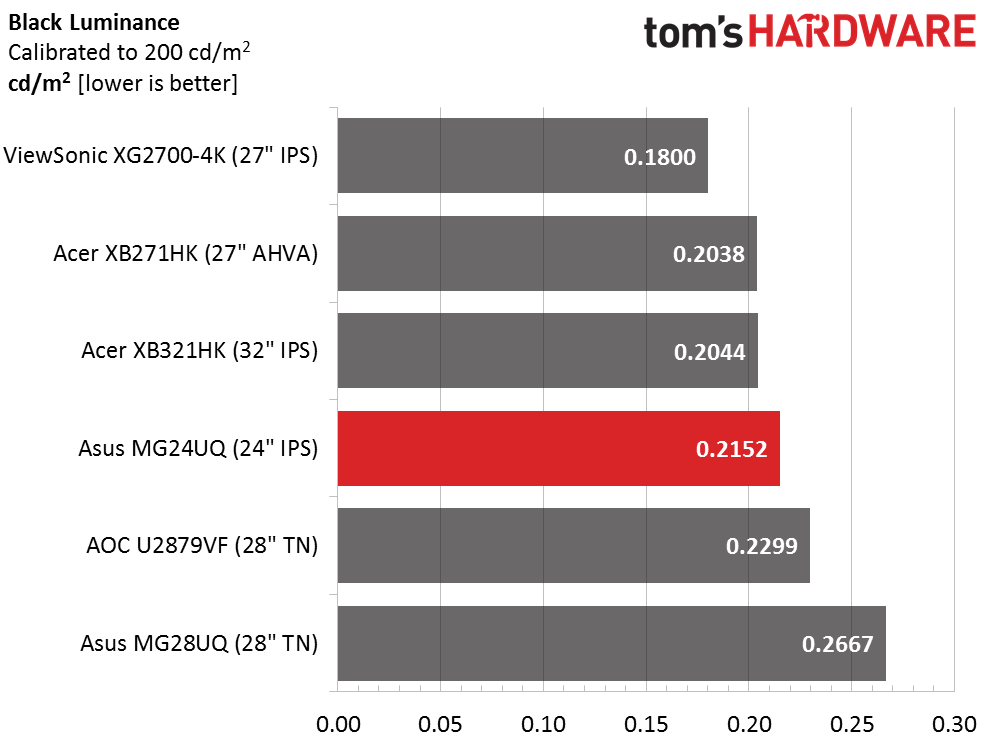
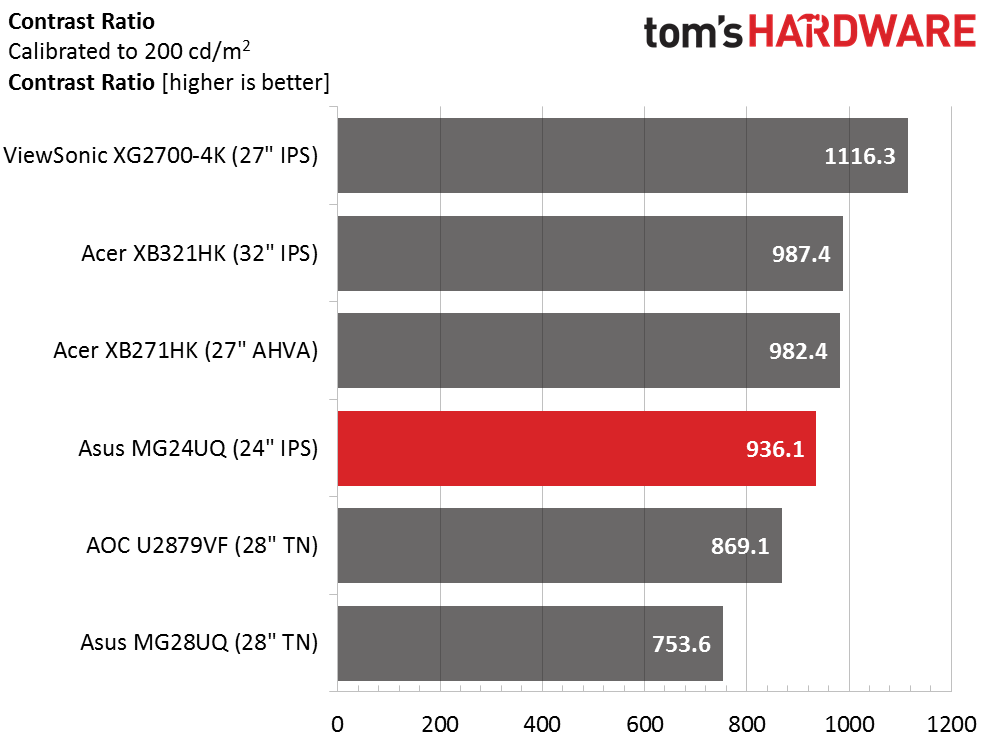
We lost a bit of contrast during calibration by reducing the Contrast slider. This was done to correct a slight blue error that we could barely see. You can also solve this minor issue by selecting the sRGB picture mode. Output is locked at 170cd/m2, but that’s a level that will work in most room environments. With our tweaks, dynamic range is only reduced by 8%.
ANSI Contrast Ratio
Most monitors post slightly lower ANSI numbers, and the MG24UQ is no exception. We’re still satisfied with its 832.3:1 result. The spoiler comes from a hotspot in the lower-right corner of the screen. Were that area more equal to the rest, the value would have been closer to 1000:1. Fortunately this did not hurt the uniformity results, which are quite excellent. So far, our benchmarks are showing the MG24UQ to be a high-quality panel.
Get Tom's Hardware's best news and in-depth reviews, straight to your inbox.
Current page: Brightness & Contrast
Prev Page OSD Setup & Calibration Next Page Grayscale, Gamma & Color
Christian Eberle is a Contributing Editor for Tom's Hardware US. He's a veteran reviewer of A/V equipment, specializing in monitors. Christian began his obsession with tech when he built his first PC in 1991, a 286 running DOS 3.0 at a blazing 12MHz. In 2006, he undertook training from the Imaging Science Foundation in video calibration and testing and thus started a passion for precise imaging that persists to this day. He is also a professional musician with a degree from the New England Conservatory as a classical bassoonist which he used to good effect as a performer with the West Point Army Band from 1987 to 2013. He enjoys watching movies and listening to high-end audio in his custom-built home theater and can be seen riding trails near his home on a race-ready ICE VTX recumbent trike. Christian enjoys the endless summer in Florida where he lives with his wife and Chihuahua and plays with orchestras around the state.
-
Larry Litmanen I honestly don't think that a 24 inch monitor should be reviewed as gaming monitor. Anything below 27 inches does not provide that deep, immersive experience.Reply
The difference between a good 30 inch monitor and a 24 inch monitor is the same as going from a 17 inch to a 24 inch. Once you experience it you can never go back. -
InvalidError 24" is a bit on the small side for UHD. I'd step up to 27-28" for that. Thankfully, 27-28" LCDs are also steadily coming down in prices and that includes UHD models. In many cases, UHD is displacing similar size QHD monitors in price.Reply
If this keeps up, UHD is going to become a really tempting mainstream desktop option next year. -
TallestJon96 I have a friend who plays on a full hd monitor with a playstation 4. He pretty dedicated to console gaming, and is considering getting either a ps4 pro or xbox scoprio when they are released. Even though these consoles do not output native 4k often, its hard to dispute that the experience is substantial improved on a 4k screen. For him, something like this screen, or a follow up about a year from now, that costs between $250-$300 along with a mid gen console could be a great combination. 24 inches is a little small, but it is not as bad when you consider that most games are less than native 4k, and the smaller the screen, the less you notice upscalling artifacts.Reply
For high end pc gaming, 1440p144hz is still the best around today. I absolutely love it. -
beshonk Toms, can you start including information regarding scaling method/interpolation used on these uhd monitors, along with a subjective analysis of what it looks like at 1080p on the uhd monitors? Even a 1080 struggles with 4k at ultra in games, and once we start seeing uhd monitors that can hit 144hz, it becomes a really important consideration if the 1080p downscaling is ok or looks blurry.Reply -
Are these monitors HDR? I have 10-bit 24" asus monitors, IPS, which have been amazing. Seeing this, I might be replacing them. But, are they HDR? 10-bit and HDR are different, from what I understand.Reply
-
photonboy Beshonk,Reply
You can scale on the monitor itself, OR on the GPU. If you setup GPU scaling then it always sends a 4K signal to the monitor so all scaling is done on the graphics card.
I don't see much issue with scaling from 1600x900 or 1920x1080 to a 2560x1440 resolution using whatevever method the GPU or monitor provides (tried both).
1080p is technical ideal to avoid certain scaling artifacts as it divides evenly, though things like aliasing (jaggies, shimmering) are far more important to avoid IMO.
I'm not sure what control we have in terms of upscaling options. Again, a game is rendered at a particular resolution and the GPU or monitor handles the scaling. Not my area of expertise I'll admit. -
shrapnel_indie What would really be nice as an interim monitor would be one that would work at the interface limits of UHD (60hz), but if ran at a lower resolution, bump up to 144Hz (QHD, FHD).... I know I know, "Why would you run at less than native," right? "The complexity for LCD is more complex and will drive the price up." etc. etc. One can dream, even if such may not be feasible.Reply -
chenw There was a sony TV line that did that (it accepted 4k/60hz or FHD/120hz), but I haven't heard of many people actually using that feature.Reply
To be honest, 4k/60hz and 1440p (or even 1080p)/144hz modes on a single monitor makes a ton of sense for a monitor, choice between Eye candy and smoothness on a click of a button. -
InvalidError Reply
40-120Hz Adaptive Sync would be even better.18589227 said:To be honest, 4k/60hz and 1440p (or even 1080p)/144hz modes on a single monitor makes a ton of sense for a monitor, choice between Eye candy and smoothness on a click of a button.
